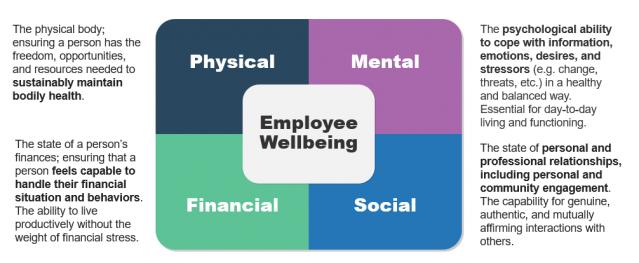Introduction
In today's fast-paced and competitive work environment, prioritizing Employee well-being and mental health is essential for fostering a positive workplace culture, improving productivity, and reducing turnover.
Organizations play a crucial role in creating supportive environments where employees feel valued, supported, and empowered to thrive.
In this comprehensive article, we will explore a range of strategies that organizations can implement to enhance employee well-being and promote mental health in the workplace, addressing both individual and organizational factors that contribute to a healthy and resilient workforce.
Understanding Employee Well-Being and Mental Health
Defining Well-Being:
Employee well-being encompasses various aspects of physical, emotional, and social health, including job satisfaction, work-life balance, stress management, and overall happiness. It reflects the overall quality of life experienced by employees in the workplace and beyond.
Importance of Mental Health:
Mental health is a critical component of employee well-being, influencing performance, engagement, and satisfaction. Poor mental health can lead to increased absenteeism, reduced productivity, and higher turnover rates, highlighting the need for proactive measures to support mental wellness in the workplace.
Creating a Supportive Work Environment
Promoting Work-Life Balance:
Organizations can support employee well-being by promoting work-life balance through flexible work arrangements, telecommuting options, and paid time off for personal and family needs. Encouraging employees to disconnect from work during non-working hours helps prevent burnout and promotes overall well-being.
Fostering Psychological Safety:
Psychological safety refers to a climate where employees feel safe to express their opinions, share ideas, and take risks without fear of retribution or judgment. Cultivating a culture of openness, respect, and trust encourages collaboration, innovation, and psychological well-being among employees.
Providing Social Support:
Building strong social connections and support networks within the workplace can buffer against stress and enhance resilience. Organizations can facilitate social interactions through team-building activities, mentorship programs, and employee resource groups focused on wellness and mental health.
Offering Mental Health Resources and Support
Employee Assistance Programs (EAPs):
EAPs provide confidential counseling, referral services, and resources to help employees address personal and work-related issues affecting their mental health. Offering access to EAPs demonstrates organizational commitment to supporting employee well-being and can help employees navigate challenges more effectively.
Training and Education:
Providing mental health training and education programs equips employees and managers with the knowledge and skills to recognize signs of distress, respond to mental health concerns, and access available resources. Training initiatives can reduce stigma, increase awareness, and promote early intervention for mental health issues.
Access to Mental Health Services:
Offering access to mental health services such as therapy, counseling, and psychiatric care through employer-sponsored health insurance plans or partnerships with external providers can help employees receive timely and effective treatment for mental health conditions.
Building Resilience and Coping Skills
Stress Management Programs:
Organizations can offer stress management workshops, mindfulness training, and relaxation techniques to help employees build resilience and cope with work-related stressors. Teaching employees practical strategies for managing stress empowers them to maintain balance and well-being in challenging situations.
Encouraging Self-Care Practices:
Encouraging self-care practices such as regular exercise, healthy eating, adequate sleep, and leisure activities can promote physical and mental well-being among employees. Providing access to wellness resources, such as fitness facilities, wellness programs, and mental health apps, supports employees in prioritizing self-care.
Promoting Workload Management and Job Design
Balanced Workloads:
Organizations should strive to distribute workloads evenly and avoid overloading employees with excessive demands. Effective workload management promotes productivity, reduces stress, and prevents burnout, allowing employees to perform at their best while maintaining well-being.
Job Crafting:
Job crafting involves redesigning or customizing job roles to better align with employees' strengths, interests, and values. Empowering employees to shape their job roles and tasks fosters a sense of autonomy, purpose, and fulfillment, enhancing job satisfaction and overall well-being.
Fostering Leadership Support and Communication
Leadership Engagement:
Leaders play a crucial role in promoting employee well-being and mental health by modeling healthy behaviors, prioritizing employee wellness, and providing support and encouragement. Leaders should actively listen to employees, recognize their contributions, and address concerns promptly and empathetically.
Open Communication Channels:
Establishing open communication channels, such as regular check-ins, feedback sessions, and town hall meetings, enables employees to voice their concerns, share feedback, and seek support from leadership. Transparent communication fosters trust, collaboration, and a sense of belonging within the organization.
Measuring and Evaluating Well-Being Initiatives
Employee Surveys and Feedback:
Regularly soliciting feedback from employees through surveys, focus groups, and one-on-one discussions allows organizations to assess the effectiveness of well-being initiatives, identify areas for improvement, and address emerging issues proactively.
Metrics and Key Performance Indicators (KPIs):
Establishing metrics and KPIs related to employee well-being, such as absenteeism rates, turnover rates, and employee engagement scores, provides quantitative data to track progress and measure the impact of well-being initiatives over time.
Conclusion: Investing in Employee Well-Being
In conclusion, prioritizing employee well-being and mental health is not only a moral imperative but also a strategic investment in organizational success and sustainability.
By creating supportive work environments, offering mental health resources and support, building resilience and coping skills, promoting workload management and job design, fostering leadership support and communication, and measuring and evaluating well-being initiatives, organizations can cultivate a culture of well-being that enhances employee satisfaction, engagement, and performance.
Together, these strategies contribute to a healthier, happier, and more productive workforce, driving long-term success and prosperity for both employees and organizations alike.
For more insights into AI|ML and Data Science Development, please write to us at: [email protected]| F(x) Data Labs Pvt. Ltd.
#EmployeeWellBeing #MentalHealthMatters #HealthyWorkplace #WorkLifeBalance 🌱💼
This post first appeared on How Can IT Companies Ensure Data Privacy In AI While Complying With Regulations?, please read the originial post: here

